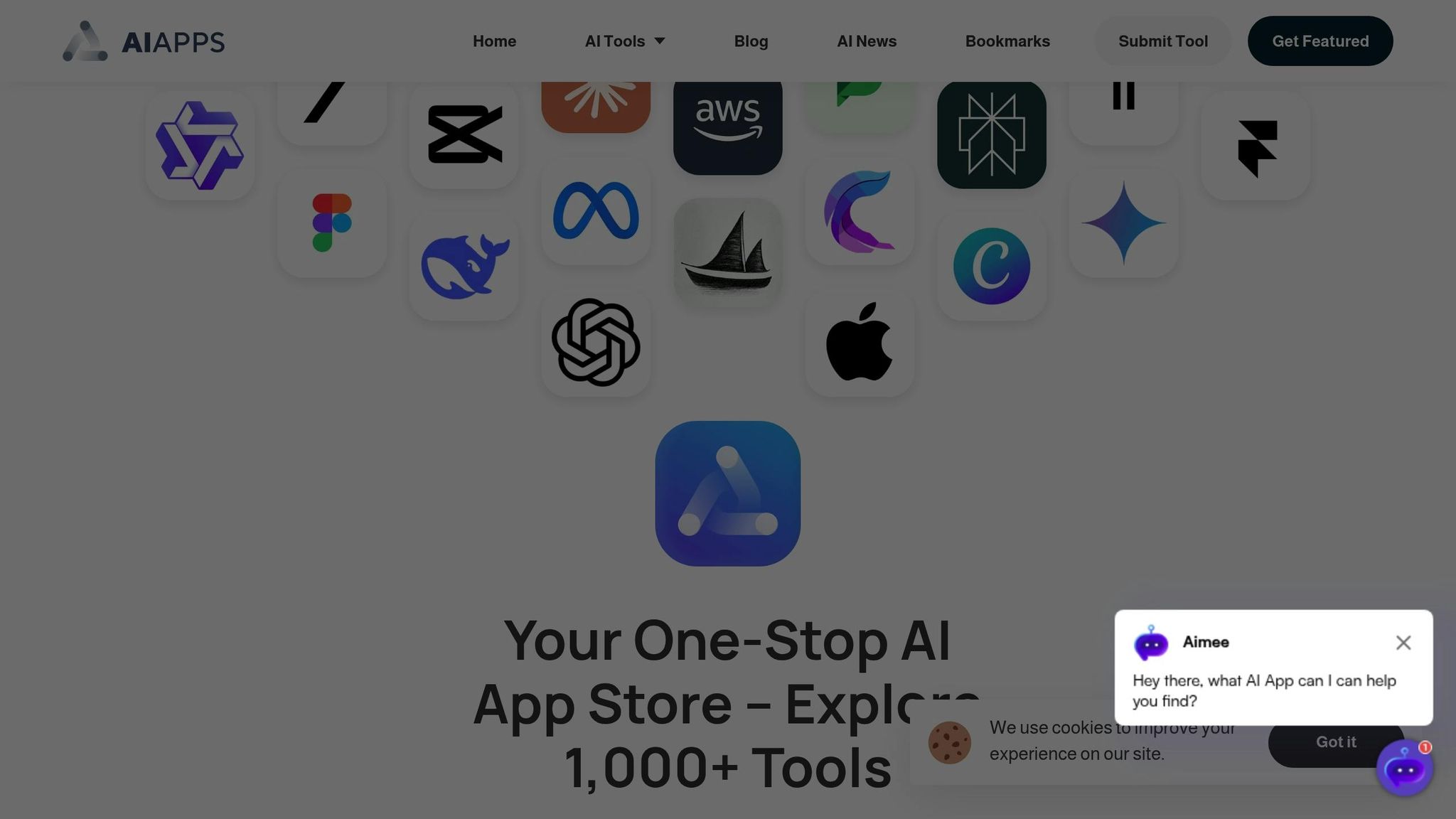AI email tools can transform your marketing efforts by automating tasks, personalizing content, and analyzing customer behavior. The right tool helps you send targeted messages, optimize campaigns, and stay compliant with U.S. laws like the CAN-SPAM Act. Here's what to look for:
- Automation: Triggered emails, list cleaning, and real-time drip campaigns.
- Personalization: Dynamic content and real-time adjustments for tailored emails.
- Segmentation: Grouping customers by behavior or predictive insights.
- Analytics: Forecasting, subject line testing, and revenue tracking.
- Integrations: Compatibility with CRMs, e-commerce, and APIs.
- Compliance: Built-in tools to meet U.S. email marketing regulations.
For U.S. marketers, prioritize tools with local support and data residency to simplify compliance and improve efficiency. Platforms like AI Apps can help you compare features, pricing, and integrations to find the best fit for your needs.
Best AI Tools for Email Automation in 2025
Must-Have Features in AI Email Tools
Choosing the right AI email tool can make or break your email campaigns. The right features ensure your campaigns are not only effective but also scalable, helping you meet your business goals.
Automation Capabilities
Workflow automation is a cornerstone of any effective AI email tool. Look for platforms that can automatically trigger emails based on specific actions, such as when a customer abandons their cart or signs up for a newsletter.
The best tools go beyond just sending emails. They can clean up your email lists by removing bounced addresses, handle unsubscribes effortlessly, segment your audience into relevant groups, and schedule emails at times when they’re most likely to be opened. Drip campaigns should also adapt in real time, changing the sequence of emails based on how recipients interact with them.
And while automation is powerful, it’s just the beginning. The next step is crafting messages that feel personal to each recipient - something we’ll dive into in the next section.
Personalization and Dynamic Content
Personalization is all about using data - like browsing habits, purchase history, and engagement patterns - to create emails that feel tailor-made.
Dynamic content blocks are a game-changer. With these, you can design a single email template that shows different content to different groups. For example, a clothing retailer could highlight winter coats for customers in snowy regions and summer dresses for those in sunnier climates, all within the same campaign.
Even better, real-time personalization takes things a step further. It adjusts email content on the fly based on a customer’s current activity or status, ensuring your recommendations and messaging are always relevant.
Advanced Segmentation
Segmentation allows you to group customers based on their behaviors, preferences, or value to your business. For instance, behavioral segmentation can identify frequent buyers, window shoppers, or deal-only customers, enabling you to tailor your approach to each group.
Predictive segmentation uses AI to go even deeper, identifying customers who might churn, those on the verge of making their first purchase, or potential big spenders. A good tool will also let you create custom scoring systems to prioritize behaviors that align with your business model.
Predictive Analytics and Reporting
AI-powered tools can use machine learning to fine-tune your campaigns. For example, they can help you determine the best time to send emails to each subscriber. Features like subject line testing and performance forecasting allow you to predict how well an email will perform before you even hit send. Add attribution tracking, and you can connect email engagement directly to revenue, giving you a clear picture of your campaign’s impact.
These analytics are most effective when they integrate seamlessly with your CRM and e-commerce systems, ensuring all your data works together.
Integration and Compatibility
Finally, your AI email tool should play well with others. Look for platforms that offer seamless, two-way synchronization with your CRM, strong e-commerce integrations, and flexible APIs. This ensures your email campaigns can evolve alongside your systems and stay in sync with your broader marketing efforts.
AI Email Tools Comparison: Features and Limitations
When selecting AI email tools that align with U.S. regulations and can grow alongside your business, it's essential to weigh their features and limitations. A careful comparison will help uncover which tools offer the best fit for your marketing goals and where compromises might arise.
AI email tools vary widely in their strengths - some shine in automating complex workflows, while others prioritize delivering personalized, engaging experiences. However, these benefits often come with trade-offs, such as limited advanced analytics or fewer integration options. Below is a breakdown of key features to help you evaluate these tools effectively.
Pricing is another major factor to consider. Pricing structures can differ significantly - some tools charge based on the number of subscribers, others by email volume, and many use tiered models that scale with your business. Understanding these costs upfront can help you avoid unexpected expenses down the road.
Performance limitations are equally important. While certain tools work seamlessly for small businesses, they may falter under the demands of large-scale campaigns. Conversely, platforms built for high-volume operations might feel overly complex for simpler needs.
Feature Comparison Table for AI Email Tools
| Feature Category | Enterprise Tools | Mid-Market Tools | Small Business Tools | Typical Limitations |
|---|---|---|---|---|
| Automation Workflows | Advanced multi-step sequences with robust triggers (e.g., ActiveCampaign offers extensive automation) | Standard workflows with moderate automation triggers | Basic drip campaigns with essential triggers | Advanced setups may require technical expertise |
| Personalization | Real-time dynamic content and behavioral triggers for tailored emails | Template-based personalization with basic segmentation | Basic personalization, like merge tags | Enhanced customization may rely on deeper data |
| Segmentation | AI-driven, predictive segmentation for precise targeting | Rule-based segmentation with some behavioral insights | Simple demographic segmentation | Nuanced segmentation needs high-quality data |
| Analytics & Reporting | Comprehensive analytics, including forecasting and attribution modeling | Standard metrics with A/B testing | Basic open and click tracking | Advanced analytics often need extra configuration |
| Integrations | Extensive native integrations and customizable APIs | Robust options for common platforms | Standard integrations for typical email platforms | Complex setups may require developer support |
| Deliverability | Features like dedicated IPs and reputation management | Shared resources with built-in monitoring | Basic tools ensuring inbox placement | High-volume sending may need specialized configurations |
| Pricing | Premium pricing for a full feature set | Moderate pricing with balanced features | Budget-friendly options for smaller campaigns | Costs can increase with added features |
| Support | Dedicated account management and direct support channels | Reliable email and chat assistance | Self-service knowledge bases and community forums | Advanced support often tied to higher-tier plans |
Beyond features, there are a few common challenges to keep in mind. Many tools come with a steep learning curve, rely heavily on high-quality customer data, or require costly upgrades to scale effectively. Even the most advanced AI email platform can fall short if your data isn’t clean or complete, which can reduce its overall impact.
A practical tip: use trial periods to test tools with realistic data volumes. This will help identify potential bottlenecks before committing to a solution.
sbb-itb-212c9ea
How AI Apps Helps You Find and Compare AI Email Tools

Choosing the right AI email tool can feel like a daunting task, especially when every platform claims to offer the best features. That’s where AI Apps steps in to make things easier. It provides a centralized hub where you can explore, compare, and evaluate over 1,000 AI tools, including those designed specifically for email marketing.
By gathering all the essential information in one place, AI Apps saves you the hassle of jumping between multiple websites. Instead, you can focus on building and refining your email strategy. And with advanced filtering options, narrowing down your search becomes even more efficient.
What sets AI Apps apart? Every tool listed goes through a thorough, multi-step verification process to ensure you’re only seeing quality solutions.
Advanced Filtering Options on AI Apps
AI Apps includes powerful filtering tools to help you zero in on the perfect AI email platform for your needs. You can sort tools by categories like automation, personalization, or analytics. Plus, you can filter by pricing models - whether you’re looking for free tools, one-time purchases, or subscription-based services.
These filters make it easier to find both well-established platforms and emerging tools with exciting potential, saving you time and effort in the decision-making process.
Important Considerations for U.S. Marketers
When selecting AI email tools for the U.S. market, it's not just about features - it’s also about ensuring compliance with local laws, secure data practices, and reliable domestic support. The regulatory environment in the United States is distinct, and overlooking these factors could lead to costly legal troubles. By keeping these considerations in mind, you can choose a tool that not only performs well but also aligns with U.S. operational standards.
Compliance with U.S. Email Marketing Laws
The CAN-SPAM Act is the cornerstone of federal email marketing laws in the United States. To comply, your AI email tool must automatically include essential elements like clear sender identification, accurate subject lines, and easily accessible unsubscribe options in every email.
Look for platforms that simplify compliance by:
- Automatically adding sender information.
- Syncing suppression lists to avoid emailing unsubscribed users.
- Processing unsubscribe requests within 10 business days.
Some tools go a step further by offering compliance monitoring dashboards, which can be particularly useful for managing multiple campaigns. These dashboards help you track adherence to CAN-SPAM requirements, reducing the risk of accidental violations that could lead to hefty fines.
Additionally, state laws like California's Consumer Privacy Act (CCPA) require specific data handling practices. Choose a platform that supports features like data deletion and opt-out request processing to remain compliant with these stricter privacy regulations.
Local Support and Data Residency
Legal compliance is just one piece of the puzzle - practical considerations like customer support and data storage are equally important for optimizing your campaigns.
Make sure the tool provides U.S.-based customer support during standard business hours (typically 9:00 AM to 5:00 PM local time) and offers multiple ways to get help, such as phone, chat, and email. For larger enterprises, some platforms even assign dedicated account managers located in major U.S. cities to ensure personalized assistance.
Data residency is another critical factor. Storing email data and analytics on U.S.-based servers can improve performance and simplify compliance, especially for industries like healthcare, finance, or government contracting, where data location is often regulated.
For the best results, choose platforms with U.S. data centers and legal entities. This not only ensures smoother compliance verification but also speeds up dispute resolution if issues arise.
Conclusion
When choosing an AI email tool, focus on features like automation, personalization, segmentation, and predictive analytics. These capabilities help create email campaigns that connect with the right audience at the right time while delivering measurable outcomes that validate your investment.
For U.S. marketers, it's crucial to select tools that automatically comply with CAN-SPAM regulations and provide local support, including U.S.-based data centers, to meet stringent regulatory and data residency standards.
The process of finding the ideal AI email tool doesn’t have to feel overwhelming. AI Apps simplifies your search by allowing you to compare over 1,000 AI tools in one place. With advanced filtering options, you can easily narrow down your choices based on specific features, pricing, and categories - saving time and helping you pinpoint tools that align perfectly with your needs.
FAQs
What compliance features should AI email tools have to meet U.S. email marketing laws like the CAN-SPAM Act?
To stay within the boundaries of U.S. email marketing laws, such as the CAN-SPAM Act, AI-powered email tools need to include certain key features. These should cover essentials like a clear opt-out mechanism, automatic handling of opt-out requests, and ensuring accurate sender information, including a valid physical postal address. It's also critical that these tools help steer clear of misleading subject lines and ensure emails are clearly marked as advertisements.
Beyond the basics, features like real-time compliance monitoring, suppression list management, and consent verification can add an extra layer of protection. These tools not only help you avoid legal missteps but also support ethical and transparent marketing practices.
What is predictive segmentation, and how can it improve email marketing campaigns?
Predictive segmentation leverages AI to dive deep into customer data, spotting trends and predicting behaviors. This helps marketers zero in on the right audience with campaigns that feel personalized and timely. By analyzing factors like purchase history, browsing patterns, content preferences, and engagement metrics, businesses can craft emails that resonate more with their audience.
The result? Happier customers and smarter campaigns. By concentrating on high-value segments and cutting down on ineffective outreach, companies can enhance both their campaign performance and return on investment (ROI).
Why do AI email tools need to integrate seamlessly with CRM and e-commerce systems?
For AI email tools, connecting seamlessly with CRM and e-commerce systems is key. Why? It ensures smooth data synchronization and helps create personalized experiences for customers. By linking these systems, businesses can streamline repetitive tasks, monitor customer behavior, and craft marketing campaigns that align with individual preferences.
These integrations also unlock real-time insights and predictive analytics, enhancing lead scoring, refining sales forecasts, and boosting marketing efforts. The result? Happier customers, smoother operations, and a stronger return on investment (ROI).



